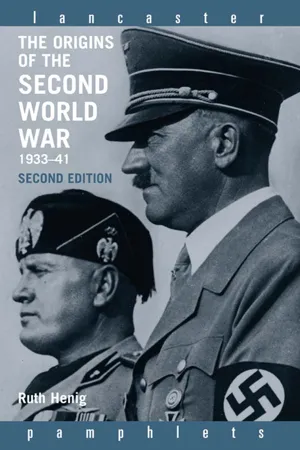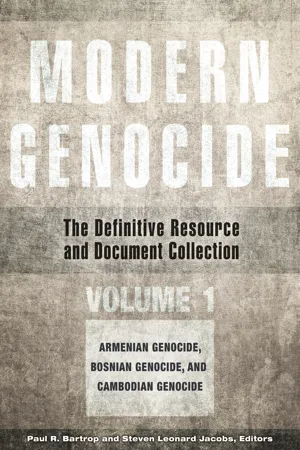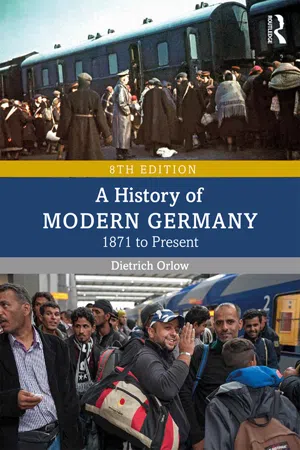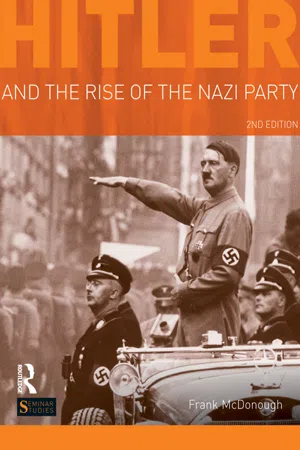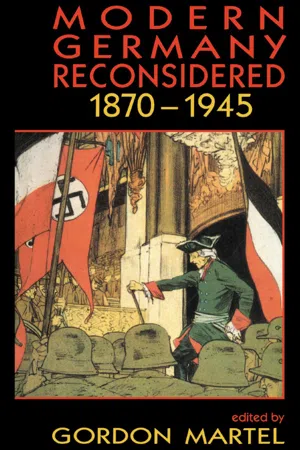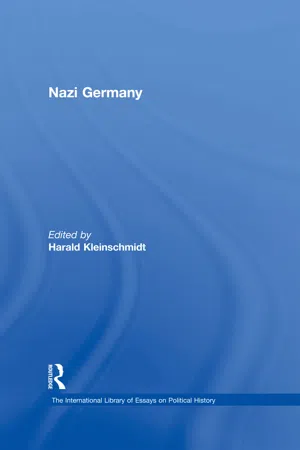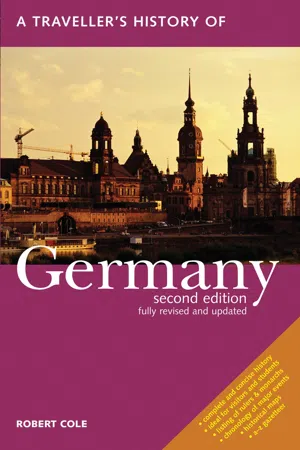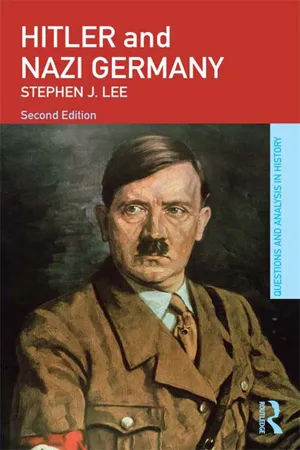History
Nazi Germany
Nazi Germany refers to the period from 1933 to 1945 when Adolf Hitler and the Nazi Party held power in Germany. This era was characterized by totalitarian rule, aggressive expansionism, and the implementation of racist and anti-Semitic policies that led to the Holocaust and the deaths of millions of people. The regime's impact on global history and its atrocities continue to be studied and remembered.
Written by Perlego with AI-assistance
Related key terms
12 Key excerpts on "Nazi Germany"
- eBook - ePub
- Ruth Henig(Author)
- 2004(Publication Date)
- Routledge(Publisher)
2 The years 1933-41DOI: 10.4324/9780203332276-3Nazi ideology
Hitler's seemingly inexorable rise to power caused anxiety both within Germany and in neighbouring countries. For Hitler was no ordinary party leader and the Nazis did not behave like members of more traditional political parties. They laid great stress on visual and verbal impact — on uniforms, on emblems such as swastikas, on endlessly repeated slogans and on carefully staged parades and marches. The use of violence was an integral part of their struggle for recognition and power, and attracted as many followers as it repelled. Their meeting places were not only back rooms in cafés and beer cellars but also street corners and public open spaces where Hitler could harangue his listeners and whip them up into a frenzy, while his armed bodyguards beat up dissenters and political opponents. The party message was kept simple: traitors inside Germany had conspired with enemies abroad to defeat Germany in 1918 and to keep it weak since that time. The Nazis demanded that these traitors be replaced by loyal German patriots like themselves, so that Germany could be 'redeemed' and regenerated. In the short term, Germany needed to recover its strength and break loose from the shackles of Versailles. It would then regain its natural mastery of central and south-eastern Europe, denied to it in the 1920s by an international conspiracy organized by Jews and communists. With Hitler at the helm and the Nazis by his side, a greater Germany, embracing all Germans including those at present living outside Germany's present frontiers, would achieve its destiny through the establishment of a thousand-year Third Reich. (The First Reich had been the medieval Holy Roman Empire of the German nation, and the Second had been the German empire as established by Bismarck in 1871.) - eBook - ePub
Modern Genocide
The Definitive Resource and Document Collection [4 volumes]
- Paul R. Bartrop, Steven Leonard Jacobs, Paul R. Bartrop, Steven Leonard Jacobs, Paul R. Bartrop, Steven Leonard Jacobs(Authors)
- 2014(Publication Date)
- ABC-CLIO(Publisher)
NNational Socialist German Workers' Party
The National Socialist German Workers’ Party, also called the Nazi Party or Nazis, was the political party of the mass movement known as National Socialism. Under the leadership of Adolf Hitler, the party came to power in Germany in 1933 and governed by totalitarian methods until 1945.After World War I, Germany was in chaos due to high inflation, high unemployment, ineffective government policies, and the financial burden of reparations mandated after World War I by the Treaty of Versailles (1919). This situation gave rise to wandering bands of nationalists, communist revolutionaries, and a significant leftist movement in Germany. Among these groups was the obscure German Workers’ Party.Hitler joined the party in 1919, hoping to find in it a means to achieve the revolution he sought. He quickly became a major player, then leader. He modified the party, took it over, and incorporated paramilitary elements. He renamed it the National Socialist German Workers’ Party and started the slogan “The Communists or Me!”Hitler then had setbacks, including the failure of the Beer Hall Putsch of 1923 and the six months he spent in a country club jail writing Mein Kampf . But the party grew, and its representation in the Reichstag, Germany’s representative body, grew also. Hitler now preferred legal takeover to a revolution, having been in one failed putsch already. Nevertheless, he was not averse to violence. The leaders of the Nazi Party’s Sturmabteilung, originally formed to protect the Nazi Party from its rivals, was becoming a rival center of power. In 1934, Hitler, as chancellor, ordered the arrest and execution of Ernst Roehm and other of the Sturmabteiling’s top leaders in what is known as the Night of the Long Knives.In 1928, the party had only 810,000 votes and 12 deputies elected to the Reichstag, versus 3.2 million votes for the communists and 9.1 million for the Social Democrats. In 1930, its total vote was 6.4 million and 107 deputies, and the party had 180,000 members. In 1932, the party had 39 percent of the Reichstag before slipping by 34 seats, and Hitler polled 13.5 million votes to Reichstag president Paul von Hindenburg’s 19.25 million. By 1934, Hitler was chancellor under Hindenburg, and Hermann Goering was president. Hitler used a fire in the Reichstag to suspend civil liberties, suppress the communists and Social Democrats (20,000 were arrested), and suspend the constitution. - eBook - ePub
Bibliography On Holocaust Literature
Supplement
- Abraham J Edelheit(Author)
- 2021(Publication Date)
- Routledge(Publisher)
3Nazi Germany DOI: 10.4324/9780429033353-4A. THE THIRD REICH1. Overviews
- 388. Barth, Hans: "Reality and Ideology of the Totalitarian State." Tr. from German by George Wack. R/P , v.l #3 (July, 1939): 275-306.
- 389. Bendersky, J.: A HISTORY OF Nazi Germany. Chicago: Nelson-Hall, 1985. 267 p. *** Reviews the origins and development of Nazism; the seizure and consolidation of power; the Nazification of German society; Hitler's anti-Jewish policy and the SS terror; World War II and the fall of Nazi Europe.
- 390. Black, Robert: FASCISM IN GERMANY: HOW HITLER DESTROYED THE WORLD'S TOST POWERFUL LABOUR MOVEMENT. London: Steyne Publications, 1975. 1,240 p. *** Documents the role big business played in financing Hitler's rise to power. Also examines the organization and policies of the German labor movement. Posits that the divisiveness between the Social Democrats and Communists aided the Nazis in their rise to power.
- > #5433. Boehm, E.: Policy Making of the Nazi Government.
- 391. Bonn, M. J.: "The Political Situation in Germany." PQ , v.4 #1 (Jan./March, 1933): 44-57.
- 392. Brown, H.: "Bloody Hitlerland: Under the Swastika!" JTr , v.10 #24 (Aug. 18, 1933): 7. *** Eyewitness account.
- 393. Carr, Joseph J.: THE TWISTED CROSS. Lafayette, LA: Huntington House, 1985. 310 p.
- 394. David, Claude: HITLER'S GERMANY. Tr. from German by Anne-Marie Geoghegan. New York: Walker, 1963. 154 p.
- 395. Duffield, Marcus: "Hitler's Germany." CH/F , v.51 #3 (Nov., 1939): 12-14.
- 396. Elliott, B. J.: HITLER AND GERMANY. White Plains, NY: Longman's, 1980. 176 p.
- 397. Fay, Sidney: "Germany under the Iron Heel." CH/F , v.38 (Apr., 1933): 102-105.
- 398. ---: "Hitler: Chancellor of Germany." CH/F , v.37 (March, 1933): 741-748.
- 399. ---: "The Hitler Dictatorship." CH/F , v.38 (May, 1933): 230-234.
- 400. ---: "Is the Nazi Revolution Ended?" CH/F , v.38 (Sept., 1933): 741-747.
- 401. ---: "The Nazi Totalitarian State." CH/F , v.38 (Aug., 1933): 610-618.
- 402. ---: "The Nazis' Birthday Party." CH/F
- eBook - ePub
The Radical Right in Germany
1870 to the Present
- Lee Mcgowan(Author)
- 2014(Publication Date)
- Routledge(Publisher)
The former were subsequently jettisoned in power by removing its advocates and the latter problem was resolved by eliminating the entire SA leadership. Thereafter, the regime pragmatically moved to consolidate its position by removing its critics and by outlawing all other political organizations and potential rivals, implemented a series of measures that were designed to ensure a firm control over the people and pursued certain policies in the realm of foreign affairs that were designed to rally the public to the Nazi banner and the cause of the Führer. The direction and, ultimately aggressive, intent of Nazi foreign policy displayed echoes of the territorial ambitions of the radical right agenda prior to and during the First World War, albeit a more grandiose and radical version. The period of Nazi rule may have been relatively short-lived but its impact on Germany and Europe was colossal. The regime was only finally toppled by a force of foreign coalition powers which, having been attacked by Nazi Germany, vowed to destroy the evils of political extremism. The two phases of Nazi history, first in opposition then in government, have drawn and continue to fascinate the wider public far more than most periods of European history outside antiquity. This may be partly explained by the availability of film and documentary materials which continue to cast their spell, but partly also by the way in which the activities of a handful of mostly self-educated individuals managed to overcome the existing political system and almost secure their goal of world domination - eBook - ePub
A History of Modern Germany
1871 to Present
- Dietrich Orlow(Author)
- 2018(Publication Date)
- Routledge(Publisher)
Apart from these incessant spectacles (the Nuremberg congresses had their counterparts on a smaller scale in the form of numerous regional rallies) what was daily life like for the average member of the Volksgemeinschaft? It was a combination of normality, fear, and conformity. The Nazis set out to establish a “totalitarian” regime in Germany, and to a large extent they succeeded. Lack of political freedom and complete control over all forms of public life constituted a yoke that bore heavily on those who valued their political and intellectual liberty.Figure 6.4 An advertisement for the Hitler Youth attempting to instill in Germany’s youth the ideal of service to Hitler. The original text translates as “Youth serves the Führer; all 10-year-olds belong in the Hitler Youth.” Note also the idealized features of the “Aryan” youth in the poster. Source: World History Archive/AlamyFigure 6.5 At the 1933 Nazi Party congress Adolf Hitler and his entourage walk past a formation of NSDAP functionaries. The man on the extreme right is Robert Ley, the Nazi Party’s head of administration and the chief of the DAF. Source: dpa picture alliance/AlamyYet there was another side to the Third Reich as well. For many Germans life under the Nazis was not all that different from what it had been before Hitler came to power. For the average, apolitical German—and this category included the vast bulk of the population—it was accommodation and conformity rather than a complete change of lifestyle that was expected. Gestapo and party agents (aided by numerous denunciations from the public at large) listened and looked intently for signs of nonconformity. Did one forget to put up a swastika flag on a national holiday? Did a Volksgenosse - eBook - ePub
- Frank McDonough(Author)
- 2014(Publication Date)
- Routledge(Publisher)
4 The Ideology of Hitler and the Nazi Party
DOI: 10.4324/9781315833095-4Nazism was a vague ‘eclectic ragbag ideology’ which drew on a wide variety of sources. It lacked the coherent, and systematic economic foundations of Marxist-Leninist communism. It is even difficult to determine whether it was ‘progressive’ or ‘backward looking’. Unlike Marxism, which aimed to destroy the existing economic and political system, Nazism was much more willing to collaborate with existing power structures, and to follow seemingly backward-looking ideas in pursuit of its objectives. Nazism also lacked the ideological backing and intellectual weight of a Karl Marx. In essence, Nazism was a rather ill-thought-out ‘third way’ between liberal democracy and communism. It grew at a time when mass democracy was being introduced in Germany for the first time and when the world economic system was greatly strained by the consequences of First World War.Nazism built its support by tapping into the negative feelings of certain sections of German society towards such things as the ‘harsh’ terms of the Versailles Treaty, high inflation, the instability of democratic government, the economic position of Jews in German society and the growth of a vibrant communist movement. Nazi ideology pointed to the ‘enemies’ inside Germany: communists, socialists, trade unionists, democrats and Jews, and then suggested the elimination of these groups from positions of power could only be achieved through a ‘National Socialist Revolution’ that would establish a strong state, led by a strong leader, determined to re-build military power, shake off Versailles and make Germany, once and for all, the most dominant power in the world.Links with Fascism and Totalitarianism
Although Nazism had many unique characteristics, there has always been a tendency to bracket it under the general label of ‘fascism’, a term which invokes words such as ‘violent’, ‘repressive’ and ‘dictatorial’. However, finding a general theory of ‘fascism’ has proved extremely difficult. For a start, there was no great philosopher who codified fascist ideology. This is hardly surprising as fascism prided itself on being anti-intellectual and opposed to ‘rational’ thought. It is not surprising, therefore, to discover that the statements and writings of the leading supporters of fascism are as dense as fog [Doc. 8, p. 116 - eBook - ePub
Digital Demagogue
Authoritarian Capitalism in the Age of Trump and Twitter
- Christian Fuchs(Author)
- 2018(Publication Date)
- Pluto Press(Publisher)
In section three, Neumann shows how Nazism’s ideology and class system interacted. Ideologically, Nazi-fascism ‘claims to have […] created a society differentiated not by classes but according to occupation and training’ (367). But in reality, under the ideological guise of racism and nationalism, it ‘deepened and solidified’ class antagonisms (367). Nazism organised society in ‘a monistic, total, authoritarian’ (400) manner that was ideologically presented as an ‘abstract “people’s community,” which hides the complete depersonalization of human relations and the isolation of man from man’ (402).The essence of National Socialist social policy consists in the acceptance and strengthening of the prevailing class character of German society, in the attempted consolidation of its ruling class, in the atomization of the subordinate strata through the destruction of every autonomous group mediating between them and the state, in the creation of a system of autocratic bureaucracies interfering in all human relations. (367)Nazism’s totalitarian monopoly capitalism deepened capitalist class structures via a terroristic state driven by anti-Semitic and racist ideology, abolished the rule of law and exercised the utmost violence.Nazi Germany’s Economy: Totalitarian State Capitalism or Totalitarian Monopoly Capitalism?
Franz L. Neumann (1944/2009, 116–20, 275) argues that the ‘Aryanisation’ of Jewish property served the expansion of German monopoly capitalist interests such as those of Otto Wolff AG (steel), Friedrich Flick’s conglomerate (steel, iron, coal), or Mannesmann (steel, iron) (Neumann 1944/2009, 275, 288–92). Also, the Germanisation of conquered economies would have been part of German Nazi imperialism (275–7). Corporations in Nazi Germany were large cartels and combines that were based on the leadership principle (233). Cartels were brought about by compulsory cartelisation (Neumann, Marcuse and Kirchheimer 2013, 270, 273–4). - eBook - ePub
Modern Germany Reconsidered
1870-1945
- Gordon Martel, Gordon Martel(Authors)
- 2002(Publication Date)
- Routledge(Publisher)
For a guide to interpretations of National Socialism, see Pierre Ayçoberry, The Nazi Question. An Essay on the Interpretations of National Socialism 1922–1975 (New York, 1981). For a good general history of the Weimar Republic, see Eberhard Kolb, The Weimar Republic (London, 1988), which also contains a section summarizing the main historiographical debates. Ian Kershaw, The Nazi Dictatorship. Problems and Perspectives of Interpretation 2nd edn (London, 1989) and John Hiden and John Farquharson, Explaining Hitler’s Germany. Historians and the Third Reich 2nd edn (London, 1989) mainly cover the post-1933 period. The most recent and valuable English-language publications on specific topics will be referred to below. 2 The evidence is discussed most exhaustively in Thomas Childers, The Nazi Voter. The Social Foundations of Fascism in Germany, 1918–1933 (Chapel Hill, NC, and London, 1983), and Richard Hamilton, Who Voted for Hitler? (Princeton, NJ, 1982). 3 See for example Fritz Stern, The Politics of Cultural Despair (Berkeley, Calif., 1961); George Mosse, The Crisis of German Ideology. The Intellectual Origins of the Third Reich (London, 1964); Hermann Glaser, The Cultural Roots of National Socialism (Austin, Tex., 1978). Some important strands of late nineteenth- and early twentiethcentury German thought are discussed in Geoffrey Field, Evangelist of Race. The Germanic Vision of Houston Stewart Chamberlain (New York, 1981); Daniel Gasman, The Scientific Origins of National Socialism. Social Darwinism in Ernst Haeckel and the German Monist League (New York, 1971); Walter Struve, Elites against Democracy. Leadership Ideals in Bourgeois Political Thought in Germany, 1890–1933 (Princeton, 1973); and Jeffrey Herf, Reactionary Modernism - eBook - ePub
- Harald Kleinschmidt(Author)
- 2017(Publication Date)
- Routledge(Publisher)
Zwangsarbeit und Vernichtung: Das Wirtschaftsimperium der SS. Oswald Pohl und das SS-Wirtschafts-Verwaltungshauptarnt 1933–1945 (Paderborn: Schoeningh, 2001).7 See the brilliant studies by Raul Hilberg, The Destruction of the European Jews (Chicago: Quadrangle Books, 1961); Saul Friedländer, Nazi Germany and the Jews , vol. I: The Years of Persecution 1933–1939 (London: Weidenfeld & Nicolson, 1997), and Peter Longerich, Politik der Vernichtung. Eine Gesamtdarstellung der nationalsozialistischen Judenverfolgung (Munich: Piper, 1998).8 On the history of the Nazi party, see Dietrich Orlow, The History of the Nazi Party , 2 vols. (Newton Abbot: David & Charles, 1969–1973); Johnpeter H. Grill, The Nazi Movement in Baden 1920–1945 (Chapel Hill: University of North Carolina Press, 1983); Michael H. Kater, The Nazi Party. A Social Profile of Members and Leaders, 1919–1945 (Cambridge: Cambridge University Press, 1983), and Kurt Pätzold and Manfred Weissbecker, Geschichte der NSDAP 1920 bis 1945 (Cologne: Papy Rossa, 1998).9 Sven Reichardt, Faschistische Kampfbünde. Gewalt und Gemeinschaft im italienischen Squadrismus und in der deutschen SA (Köln: Böhlau, 2002).10 Oded Heilbronner, “The Role of Nazi Antisemitism in the Nazi Party’s Activity and Propaganda: A Regional Historiographical Study,” Leo Baeck Institute Year Book , vol. XXXV (1990), pp. 397–439; idem, “Where Did Nazi Anti-Semitism Disappear to? Anti-Semitic Propaganda and Ideology of the Nazi Party, 1929–1933. A Historiographic Study,” Yad Vashem Studies , vol. XXI (1991), pp. 263–286.11 Dirk Walter, Antisemitische Kriminalität und Gewalt. Judenfeindschaft in der Weimarer Republik (Bonn: Dietz, 1999).12 Heinrich Popitz, Phänomene der Macht , 2nd , revised ed. (Tübingen: Mohr, 1992), p. 48 (my translation). See Trutz von Trotha, “Zur Soziologie der Gewalt,” in idem, ed., Soziologie der Gewalt. Sonderheft der Kölner Zeitschrift für Soziologie und Sozialpsychologie - eBook - ePub
- Robert Cole(Author)
- 2014(Publication Date)
- Interlink Books(Publisher)
CHAPTER ELEVEN Nazi Germany and the Second World War, 1933-1945 Adolf Hitler’s term as Chancellor of the Weimar Republic began in January 1933 as ‘a change of administrations.’ In 1934 he turned his office into that of a totalitarian dictator and initiated the Third Reich. It would stand, he assured his subjects and the world, for a thousand years. The First Days Hitler’s detractors saw him as a ‘prisoner’ of Alfred Hugenberg, and too much the amateur to deal with Germany’s many problems. The people would resist him; and there would be foreign intervention against his regime. They could not have been more wrong. Hitler’s objective from the first moment, as Hitler biographer Joachim Fest phrased it, was to ‘gather all the threads of power into his own hand by the time the eighty-five-year-old President [Hindenburg] died. And he knew how to go about it. . . .’ THE REICHSTAG FIRE That included exploiting the Reichstag Fire. Less than a month after Hitler became Chancellor, the Reichstag building was gutted by fire. This occurred one week before the Reichstag elections Hitler had called for immediately he was in office. Now, with his cohorts in strategic offices, such as Herman Goering in control of the Prussian police, he was able to launch a ‘reign of terror’ that effectively sabotaged the election campaigns of opposition parties. It was recorded that upon hearing that the Reichstag was ablaze, Hitler exclaimed, ‘Now I have them!’ The Nazis claimed that Communists set the fire, a claim supported by Marinus van der Lubbe, a Dutch Communist caught in the burning building ‘triumphantly babbling, “Protest! Protest!” ’ He was arrested and charged with arson. The next day, on Hitler’s advice, Hindenburg issued a presidential decree for the ‘Protection of the Volk and State’ on the grounds that the fire was ‘the signal for a Communist uprising.’ The decree empowered Hitler as Chancellor to arrest Communists and temporarily suspend civil liberties generally - eBook - ePub
- Stephen J. Lee(Author)
- 2013(Publication Date)
- Routledge(Publisher)
The Führerprinzip was upheld by all the organs of a totalitarian state. The Ministry of People’s Enlightenment and Propaganda manipulated his image on radio, in films and in the press, the Hitler Youth focused upon him the loyalty of youth and the RAD ordered the lives of the workforce to fit his vision of society. But the extent to which Hitler was personally involved in directing the new structure was another matter. As will be shown in Analysis 2, a vacuum developed at the centre of power, resulting in conflicts and chaos which – paradoxically – were both the antithesis and the hallmark of the personalised dictatorship of Nazi Germany. The Nazi state differed from most others in one important respect – it represented only a selected part of the population. Those Germans who were defined by racial criteria as Aryans were considered to be integral to the Volksgemeinschaft. Others were excluded: social ‘deviants’, hereditarily ‘diseased’, ‘undesirable’ groups and racial ‘inferiors’ – especially Romanies and Jews. For some of these the state exercised punitive powers, for others the protection normally conferred by the state on behalf of its citizens was removed altogether. The implications were huge, with the passing of discriminatory legislation such as the Nuremberg Laws (1935), the growth of a network of concentration camps, the compulsory sterilisation of targeted individuals and groups, and, in extreme cases, the application of ‘euthanasia’. Above all, a policy of extermination was adopted from 1941 onwards. In the Nazi dictatorship the role of the state was therefore not only that of ‘selector’, but also of ‘eliminator’ - eBook - ePub
Staging the Third Reich
Essays in Cultural and Intellectual History
- Anson Rabinbach, Stefanos Geroulanos, Dagmar Herzog, Stefanos Geroulanos, Dagmar Herzog(Authors)
- 2020(Publication Date)
- Routledge(Publisher)
Whether “race” was to be defined biologically, culturally, anthropologically, or philosophically remained, at least in principle and for a time, a relatively open and controversial question. What was crucial, however, was not that compulsory concepts were decided upon, but that such questions were discussed in the schools, the judiciary, and in the university faculties. The Nazi worldview came to appear, in short, not to be something that went against the current of older intellectual conceptions, but rather as something consistent with already existing conventions and controversies. Fusion concepts like “reactionary modernism” usefully demonstrate that there was no single distinctive German path to modernity that emerged after World War I in circles identified with the Weimar conservative Cultural Revolution. An embrace of technology and innovation was entirely compatible with Germanic spirituality, anti-materialism, imperial ambitions and a racist worldview. 79 The omnipotence of the human will to control, the principle of unlimited technical possibilities for the perfection of the nation or race, and finally, an inner readiness to embrace “final solutions” as a form of politics—and thereby to throw moral inhibitions overboard—created the climate for National Socialism. 80 Art and the Gesamtkunstwerk thesis: holistic and synthetic approaches to Nazi aesthetics Art played a crucial role in the representation and execution of racial ideology
Index pages curate the most relevant extracts from our library of academic textbooks. They’ve been created using an in-house natural language model (NLM), each adding context and meaning to key research topics.
